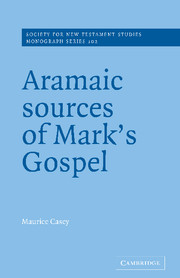Book contents
- Frontmatter
- Contents
- Preface
- List of abbreviations
- 1 The state of play
- 2 Method
- 3 Jesus' scriptural understanding of John the Baptist's death: Mark 9.11–13
- 4 Two sabbath controversies: Mark 2.23–3.6
- 5 The question of Jacob and John: Mark 10.35–45
- 6 Jesus' final Passover with his disciples: Mark 14.12–26
- 7 Conclusions
- Select bibliography
- Index of passages discussed
- Index of names and subjects
2 - Method
Published online by Cambridge University Press: 22 September 2009
- Frontmatter
- Contents
- Preface
- List of abbreviations
- 1 The state of play
- 2 Method
- 3 Jesus' scriptural understanding of John the Baptist's death: Mark 9.11–13
- 4 Two sabbath controversies: Mark 2.23–3.6
- 5 The question of Jacob and John: Mark 10.35–45
- 6 Jesus' final Passover with his disciples: Mark 14.12–26
- 7 Conclusions
- Select bibliography
- Index of passages discussed
- Index of names and subjects
Summary
The purpose of this chapter is to propose a methodology for reconstructing Aramaic sources which lie behind the synoptic Gospels. We must begin by surveying the languages which were in general use in Israel during Jesus' lifetime: Latin, Greek, Hebrew and Aramaic.
Latin was the language of the Roman imperial power. It is consequently found in inscriptions. One of the most famous was set up by Pontius Pilatus, Praefectus Iudaeae during at least the latter part of Jesus' ministry. It comes from a building in Caesarea, the Roman capital of Judaea and the normal residence of the Praefectus Iudaeae:
]S TIBERIEUM
PON]TIUS PILATUS
PRAEF]ECTUS IUDA[EA]E
This is the language of power, and we may not infer from it any widespread use of Latin.
Other people in Israel who will have known some Latin include Herod Antipas, the tetrarch of Galilee during Jesus' ministry. He was educated in Rome for several years (see Jos. AJ XVII.20), and he maintained Herod the Great's description of his supporters as Herodiani. How much he used this language, however, we do not know.
It follows that Jesus is not likely to have had the opportunity to have learnt Latin, and that it would have been of little use to him if he had.
Greek was much more widely used, throughout Israel. It had begun to spread through Israel after the conquests of Alexander the Great. A number of Greek cities were founded, and some older cities were hellenised.
- Type
- Chapter
- Information
- Aramaic Sources of Mark's Gospel , pp. 73 - 110Publisher: Cambridge University PressPrint publication year: 1999



